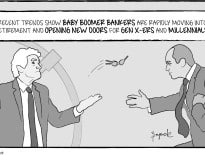When reporter Steve Adams set out to write about the lack of diversity in commercial real estate, he expected to research and write an article for this issue of Banker & Tradesman and move on to the next hot topic by next week.
What he found was a community so distressed by its own failings, and so determined to correct them, that he had to break the reporting into a two-part story. The first part, focusing on minorities, is in this issue; next week he will tackle the lack of women in the industry.
Adams’ article lays out the reasons why the industry lacks diversity. At the heart of it, it’s a cyclical problem – there are not a lot of minority or women leaders, which means a lack of minority and women mentors, and thus there are few minority and women leaders in the next generation. Adjacent to that, CRE is an insular community the world over, but especially so in Boston. Deals are made and jobs are found through a strong and tightly-knit community – in which minorities and women are underrepresented. Representation matters. The cycle repeats.
The first part of this series – currently planned as a duo, but which may stretch beyond that – is almost twice as long as the usual B&T article. That’s because the issue is complex and the solutions are varied. It’s also because the people quoted in it were eager to talk (which, it must be noted, is not usually the case).
Look around any CRE networking event and here’s what you’ll see: a sea of white, male faces. Vitally important to changing the complexion of that sea is that the white male faces have recognized that they have a problem.
Women and minorities can – and most certainly have – work twice as hard as their white male counterparts and receive half of the recognition (and often in the case of the women, half of the pay). They can fight for a seat at the table and in the board room and they can turn around and offer a hand to others on their way up the ladder. That is a long, slow progression towards change, and the achievements of those who have done so deserve recognition for their achievements.
For too long minorities and women have labored in the face of systemic barriers to entry in many fields, not just commercial real estate, while the c-suite in those fields have refused to recognize that there is a problem, that there are barriers to entry – and that a diverse workforce benefits more than minorities. A diverse board is more successful. A diverse company is more profitable. And a diverse workforce benefits us all.
After the recognition of the problem come the challenges of addressing it. Greater Boston’s CRE industry has, to its credit, recognized that it has a problem and is ramping up its response. From wildly successful inclusive internship programs to intentional mentorship, the industry is finally beginning to address the sins of omission committed by its ancestors. It will be the better for doing so, and so will our local economy and communities.





